The Outlaw Josey Wales by Clint Eastwood (Review)

“Revengeful badass.” These words are commonly used to describe Clint Eastwood’s character in an array of movies, but never have they been placed so fittingly as in this one. Alright, so the number of vengeful cowboys in westerns is countless, but Josey Wales brings a harder edge to the whiskey. His reasons for revenge are just as common. His family was murdered, his house burnt to the ground, and his pride fell with him as Union soldiers rode around the blaze. Fortunately for the viewer, they picked the wrong Missouri farmer to piss off.
With a heart set to kill those that terrorized him and any who happen to interfere, the movie is loaded with six gun shootouts, as Wales spits tobacco juice upon each victims’ unlucky forehead. The flick contains every aspect of a classic western and makes one wonder if The Outlaw Josey Wales is the greatest western ever made.
It seems as if the great Sergio Leone (patented the spaghetti western) or even John Ford may never have succeeded the westerns created by Clint Eastwood. However, if I were to direct a movie I also starred in, my badass quotient would be pretty high, too. Eastwood definitely gave more control over situations to his characters and created them more mysteriously (a la Pale Rider). The way Josey Wales keeps to himself and internally battles good and evil as he picks up lively characters along the way shows more complexity than the typical unknown gunslinger.
Though he takes lives easily throughout the film, he also gives life to characters. Lone Watie (George) is the most colorful of these and provides the film with its most disturbing scene; an old man making love to a young woman. Lone Watie, an old Apache still trying to defend his land, brings humor to the film, but in a respectful way for Native Americans, as Eastwood usually makes sure of in his movies. The meeting with Ten Bears and Wales also shows the respect for Indians that many of Eastwood’s characters portrayed and adds to the quotient. “I’m here to either live with you or die with you,” Wales tells the war chief, summing up his view of life.
What is a western without a love story? Probably a better one… The Outlaw’s heart is put to the flame when he meets Laura Lee (Locke), saving her from the raping and pillaging that upset her family’s camp. Laura Lee softens the callous heart of Josey and reveals a bit of it, since seeking revenge seems to empty more than fill. However, it’s evident she hasn’t totally softened the man. She sits by the fire telling Wales of all the different suns in Kansas, and he gives the ultimate putdown; “I always heard there were three types of suns in Kansas; sunflowers, sunshine, and sons of bitches.” I tend to watch Eastwood’s movies for moments such as this.
Though the Outlaw realizes his life must return to some normalcy in the heat of his revenge, the bullets he puts in those hunting him are priceless. There may be just as many one-liners as bullets, too. As he comes face to face with a bounty hunter in a saloon, the gunman tells Wales that a man has to make his living some how. The Outlaw replies with, “Dying ain’t much of a living,” and then proceeds to drill holes in the predator turned prey.
A revengeful cowboy may not be the most original of plots, but the gratuitous violence, various characters, and awkward dialogue provide the mixture for a classic. Released in 1976, it has certain advantages over those released prior, and shows up any westerns released later on.
Written by Nolan Shigley.
